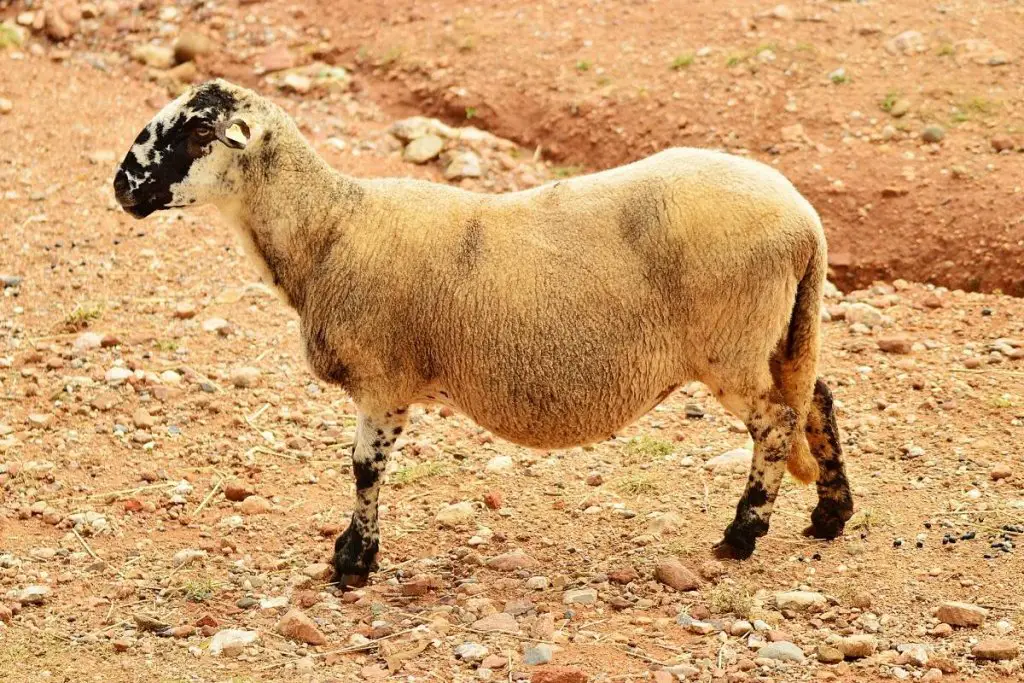Sheep are typically pregnant for around five months. Sheep pregnancies can range from 138 days to 159 days. You can tell when to expect the lambs because pregnant ewes' bellies will start to swell during the final months of pregnancy, and ewes will start to produce colostrum in the 14 days before giving birth.
Table of Contents
Average sheep gestation period
On average, a pregnant female sheep will give birth in 147 days (four months and 27 days).
Different breeds of sheep may have different gestation periods. Breeds that mature faster have shorter gestation periods. Breeds that often give birth to twins or triplets also have shorter pregnancies.
Meat sheep breeds generally grow faster. Ewes from these breeds are also likely to carry twins. They generally have short pregnancies.
Meat sheep breeds with shorter pregnancies include:
- California Red Sheep
- Corriedale
- Dorper
- Dorset
- Finnsheep
- Hampshire
- Katahdin
- Montadale
- Shropshire
- Southdown
- Suffolk
Wool sheep breeds generally mature slower. Ewes from these breeds have a longer gestation period.
Wool sheep breeds with longer pregnancies include:
- Greyface Dartmoor
- Lincoln
- Merino
- Rambouillet
- Wensleydale
How do you know if a sheep is pregnant?

Most signs of pregnancy are only noticeable near the end of pregnancy. Early pregnancy signs are subtle and might not be completely accurate.
If you want to be sure of a ewe’s pregnancy early on, you may choose to take an ultrasound test or a blood pregnancy test.
Ultrasound
An ultrasound is a highly accurate way to identify a pregnant sheep. This test can confirm pregnancy as early as 35 days after breeding.
It can also detect twins or triplets within 35-90 days after breeding. The biggest downside of ultrasound tests is that they can be expensive.
Blood testing
Blood testing is another accurate way to test for pregnancy. It is 98% accurate. You can have your ewes tested as early as 28 days after breeding.
Blood testing is more affordable than ultrasound testing, and many ewes can be tested at once.
Other ways to know if sheep are pregnant:
Weight gain
Pregnant ewes gain weight a month or two after breeding. You can be almost sure of pregnancy if the ewe gains a significant amount of weight four or five months after breeding. The weight gained during this period comes from fetal growth.
You might also notice that the ewe’s belly has grown bigger. Sometimes, the belly might look uneven. This is normal because the lamb (or lambs) might be positioned on one side of the ewe’s uterus.
Lack of interest in rams
If a ewe is in heat but is not showing any interest in rams, she might be pregnant. Likewise, rams also do not show interest in pregnant ewes.
You can try using a teaser ram and see if the rams are interested in the ewes, or vice versa.
Changes in udder, teats, and vulva
A pregnant ewe’s body will prepare itself for milk production. This usually happens around three months during her pregnancy. You will notice the udder becoming rounder and the teats hanging lower.
You will also notice the ewe shedding the wool around her teats. Around the same time, you might also notice the vulva area becoming puffy.
Lamb movement
Sometimes a swollen belly can mean something besides pregnancy. But if you see the ewe lamb or lambs kicking and moving in the ewe’s belly, you can be sure she is pregnant.
You can use your hands to feel the lamb movement during months three to four.
Colostrum production
Colostrum is the nutritious first milk that lambs drink. It is richer in fat and nutrients compared to regular ewe’s milk. Colostrum looks yellower and feels thicker than regular milk.
Production of colostrum means lambing is very near. A pregnant ewe produces colostrum within the final 14 days of pregnancy. If you squeeze your ewe’s teats and notice this thick, yellowish milk, it means your ewe is about to give birth.
How often can sheep get pregnant?
Ewes are “seasonally polyestrous.” This means that ewes only breed for certain seasons. During that season, ewes have regular heat cycles where they accept rams for mating.
Because a ewe’s gestation period is around five months long, sheep can usually only get pregnant and give birth once a year.
Ewes that have just given birth need around a month of rest. This is so their uterus can recover and return to its non-pregnant state. Ewes will start ovulating again 17-20 days after giving birth. This first ovulation after lambing is usually not fertile.
To be safe, breeders wait at least 30 days after lambing before getting the ewe pregnant again.

